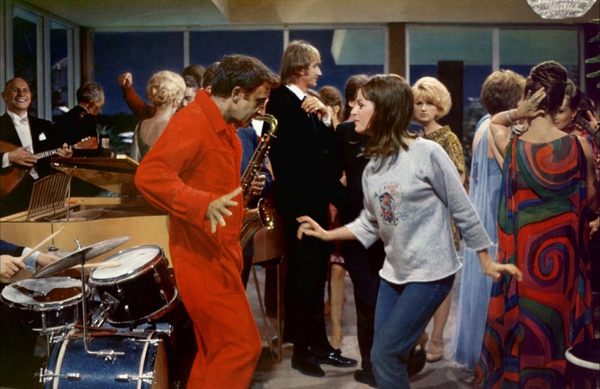A Ghost in the Dreamhouse

On the fate of films in former Soviet countries
Sometime during the last decade, in the outskirts of Yerevan, Armenia, the imposing David of Sassoun relief dropped off the façade of Armenfilm Studio. A former employee suggested that the fall of this national hero and symbol of liberation was perhaps the studio’s way of making itself heard about what had become of Armenfilm.
My first visit to the studio was in June 2004, the week before Reagan died. I remember stacks of film cans, dark corridors, threadbare carpets, Russian signage, and the stench of cigarette smoke. Old Soviet studios were my thing. It wasn’t just the buildings, it was the archives, the staff. Speaking to people who worked on these films made it all feel real.
Armenfilm was established in 1923. In the late 1960s, it was given the name of Hamo Bek-Nazarov (1892 - 1965), an actor, writer and director widely acknowledged as the founder of Armenian cinema. Although Bek-Nazarov began his career in Moscow as an actor, he established himself as a writer and director in Georgia. Amongst his Georgian films is Patricide (1921), adapted from the novel from which Stalin took his nom de guerre – Koba. Additionally, the filmmaker also directed the first Armenian film, Namus, in 1925. Bek-Nazarov’s work is only one of many examples of the way national cinemas of the region have always involved a mix of different Soviet nationalities, cultures and influences — a richness which, throughout history, has often perversely appeared to turn into a hindrance.
The purpose of my visit to Armenfilm was to interview Yuri Sayadian, a sound engineer who had worked on The Colour of Pomegranates (1969). It was thirteen years since Armenia had regained its independence. Yet Armenian film production, heritage and exhibition was in question. Film production had ground to a halt. What remained was not so much a dream factory as a haunted house. What would happen to Armenfilm Studio? What would become of the films? What would happen to Yerevan's cinemas? These three questions concerned the material legacy of Soviet cinema. There was, however, another question of a more ideological character: what constituted an Armenian film?
***
While waiting for Sayadian, I flipped through a book of black and white photographs glued onto powder blue sugar paper. They documented the location scouting in Armenia and Georgia during pre-production of Sayat Nova – the subject of The Colour of Pomegranates and the title of the film during shooting. With perverse pride, one employee bragged of being fired by Parajanov. Another gestured to one of the photographs, and said it was in this Georgian church interior that the climactic scene was shot, where headless chickens flap their wings, knocking over lit candles.
‘This symbolises the Genocide.’
‘No’, the other employee said, ‘the Genocide is symbolised by the scene of Muslims using scythes to cut the grass growing on the rooftops of the Monastery in Haghpat.’
Earlier that week I had visited Haghpat Monastery, a UNESCO world heritage site. When Sayadian arrived, I told him about the flocks of swifts I had seen and heard at Haghpat – a detail prominent in his sound design. Before leaving, I asked if I could see what remained of Confession, an autobiographical film Parajanov started filming but which he had to abandon because of the cancer that would kill him. Costumes and props are, for me, exciting and disappointing in equal measure. On the one hand, you can touch what you can only see on film. On the other, it quickly becomes apparent that the magic resides in neither costumes or props, but actors and directors.
The sound stages, production facilities, costumes and props of Armenfilm were however promised a new lease of life a year later, in 2005, when the studio was sold by the state to CJSC Armenia Studios, part of a holding company, owned by an American businessman of Armenian descent, Gerard Cafesjian. The new landlords also planned to digitise Armenfilm’s back catalogue of about a hundred films. Private enterprise had come to the rescue — or so it seemed. The redevelopment never happened. No new films were produced, and only a handful of titles from the back catalogue were telecined in standard definition. The deal remained unfulfilled, and in 2015 Armenfilm reverted to the Armenian state.
One of Our Film Prints is Missing
I returned to Yerevan in autumn 2006. I met Albert Yavouryan, the cinematographer on both Parajanov’s Ashik Kerib and Confession. The filmmaker Don Askarian wanted to make a film based on Tolstoy’s Hadji Murat, but the script needed to be in English. His ace in the hole was a studio executive who would do anything for the Armenian woman in Hollywood who wanted to produce the film.
The Colour of Pomegranates, now a classic, entered production with less sensation. The film was part of the Soviet balancing act that involved promoting national identity (i.e., a film of Sayat Nova, Armenia’s national poet), while at the same time fostering unity. Sayat Nova was fluent not just in Armenian, but also in Georgian and Ottoman Turkish, and was therefore not just a symbol of Armenia, but of the Caucasus as whole – even if the experiment which was the Transcaucasian Socialist Republic, which existed just fourteen years, between 1922 and 1936, had been a failure, Armenia, along with Georgia and Azerbaijan, existed together as socialist republics, members states of the Soviet Union.
Armenfilm may have produced The Colour of Pomegranates, but its production was both monitored and approved by Moscow. Yes, this was Big Brother, but no more so than an independent Hollywood producer who bankrolls their film with the support of a studio with strings attached. A casual look at the memos exchanged between Moscow and Yerevan reveal bureaucrats less concerned with ideological correctness than with missed schedules, cost overruns, equipment failure, casting suggestions and concerns about whether casual audiences would make sense of the final product - sound familiar?
***
But what was a somewhat unobtrusive influence during production turned into a much more controlling and contentious one once the film was completed. Parajanov produced his cut of The Colour of Pomegranates, but when it came to distributing the film outside of Armenia, Goskino, the state film committee, recut his film. Contrary to popular belief, The Colour of Pomegranates was not banned, rather it was given what was known as third category distribution. This meant that prints only circulated amongst specialists and film clubs. It was the Soviet equivalent of a Hollywood studio burying an embarrassing release in the schedule with few prints, no preview screenings and symbolic marketing. As was the case with most Armenian feature films produced during the Soviet era, the original camera negative was deposited in Gosfilmofond, the Russian state film archive just outside of Moscow in Belye Stolby.
After years of being closely looked at and monitored by the authorities Parajanov was imprisoned in a labour camp in Dnipropetrovsk, Ukraine, in 1973, putting an immediate stop to the international distribution of The Colour of Pomegranates. A print of the uncut, Armenian version was, however, smuggled out of the Soviet Union, and screened as part of the international campaign to free the filmmaker. According to the former director of the ICA cinema in London, the KGB attempted to retrieve the rogue print from their projection booth. The question of how the print got out of the Soviet Union now has its own mythology. In one story, the print made its way out of Armenia into pre-revolution Iran. Another tells of a visiting Polish delegation who smuggled reels out of the country in their luggage.
It was only in the 1980s, as the Soviet leadership passed from Leonid Brezhnev to Yuri Andropov, that Parajanov’s films — including The Colour of Pomegranates — were once again authorised to be exported abroad, via Sovexportfilm, the official, centralised state body for the international promotion of Soviet film.
An Armenian film, The Colour of Pomegranates was created under the supervision and control of Soviet officials, whose wavering sympathy for Parajanov’s work caused the film (and its filmmaker) a tumultuous existence. But questions of rights, distribution, and preservation would take on an even more labyrinthine quality later, following the disintegration of the Soviet Union.
Armenian Negatives in Russia
Parajanov died in 1990, the year after the fall of the Berlin Wall, and the year before Armenia regained its independence. During the Cold War, he was perceived in the West as a Soviet, and therefore, Russian filmmaker. In 1991, when Armenia regained its independence, the rights to The Colour of Pomegranates reverted to Armenfilm. The negative, however, remains in Russia.
Armenfilm therefore stuck a new 35mm release print of a duplicate negative of Parajanov’s original Armenian version, which was both licensed and promoted abroad as the director’s cut. Today however, the chemical laboratories at Armenfilm which made the creation of new prints possible have long since disappeared, while the negatives of most of the films produced by Armenfilm remain in Gosfilmofond, Russia.
In 2006, the Armenian Ministry of Culture established the National Cinema Centre of Armenia. The inter-positives, duplicate negatives, and theatrical release prints of Armenian films remain under the management of the National Archives of Armenia, also accountable to the Ministry of Culture. Currently, however, neither the Cinema Centre nor the Archives has a scanner, so the only way to see the films produced by Armenfilm is from 35mm archival prints or telecined copies for television broadcast.
Yerevan’s Soviet film theatres
While films are difficult to come by, the situation concerning the actual cinemas in which they might be shown isn’t any less complex.
In 2004, I arrived in Yerevan through the old Zvartnots Airport terminal, a brutalist concrete circle with an imposing tower at its centre. It is a vision of the future, albeit a Soviet one from the 1960s. Yet, as the plane taxied, I had a feeling of déjà vu. During the 1980s, Zvartnots Airport had been used as a location for the Polish children’s film, Pan Kleks w kosmosie (Mr. Blot in Space). When I returned in 2006, I arrived at a brand-new terminal, a vision of capitalist realism, festooned with advertisements for Armenian cognac. Five years later, in 2011, the old terminal had been abandoned.
For visitors from the West, decaying brutalist shells are exotic, melancholic relics of a dead empire. For those in the East, they are daily reminders of past oppressors. The most striking example of Soviet brutalism in Yerevan city centre is Kino Rossiya, whose construction began in 1968, the same year The Colour of Pomegranates entered production. It consists of two, asymmetrical auditoriums on cantilevered stilts, which could accommodate two and a half thousand spectators. This was where the Armenian premiere of Parajanov’s Ashik Kerib was held. Today, locals prefer to call it not Rossiya but Ararat, after the dormant volcano dominating Yerevan’s skyline and whose shape the building mimics. After the disintegration of the Soviet Union, Rossiya closed and the building and the land around it were bought by an oligarch, who uses it as market space.
Two functioning cinemas dating from the Soviet era however remain in Yerevan – Nairi and Moskva. Of the two, Nairi is the oldest. In 1926, Bek-Nazarov’s Zare premiered at the Nairi in its original location on Amiryan Street (the current building was constructed during the late 50s). Moskva, meanwhile, was originally built during the 1930s and opened with the premiere of Bek-Nazarov’s Pepo, Armenia’s first sound film. Built in the constructivist style, it also has an outdoor cinema – currently out of use. Both cinemas were privatised during the 1990s. Today, Moskva remains at the heart of Yerevan’s film culture — it can still project from 35mm film prints, and is also the hub of Yerevan’s Golden Apricot International Film Festival. The management strives to balance commercial fare with subsidised cultural events. To balance the books, it recently sold off part of the foyer which is now a boutique hotel.
The role of Soviet cinema in Post-Soviet nation building
Although it has been decades since the fall of the Soviet Union, intricacies of nationality and origin when it comes to cinema produced during the era continue to have repercussions today, both nationally and in the wider international reception of Soviet art.
On September 18, 2020, American singer-songwriter and diva Lady Gaga released Tarsem Singh’s video for her song 911. Unlike Tarsem’s 1993 video for Deep Forest’s Sweet Lullaby (which reproduces imagery from Parajanov’s Legend of Surami Fortress, produced by Georgian Film in 1984), 911 ends with a coda, with ‘Gwen’ lying injured outside a cinema, the marquee of which is advertising an ‘Armenian Film Festival.’ A brief shot reveals two posters: one is Sam Ashby’s artwork for Second Sight Films' blu-ray of The Colour of Pomegranates (full disclosure: I worked on this release as a consultant, editor, and extras producer), and the other is the Russian export poster for Parajanov’s Ashik Kerib. If Twitter is anything to go by, then the response from both Armenia and the diaspora was positive – Lady Gaga had both affirmed and approved Armenian culture. Nine days later, on September 27, the second Nagorno-Karabakh war broke out between Armenia and Azerbaijan. Pro-Armenian memes proliferated on social media, featuring imagery from The Colour of Pomegranates — inevitably followed by responses that the actor featured, Sofiko Chiaureli, was in fact Georgian.
In the post-Soviet period, histories of regional cinemas were developed along nationalist lines – Russian cinema, Ukrainian cinema, Georgian cinema, and Armenian cinema. Parajanov and his films have been adopted by each of these countries as they have sought to reconstruct their national identities. But while the negatives of Parajanov’s films remain in Russia, and the Armenian, Georgian and Ukrainian states have reclaimed the commercial rights to his films, 1993 seemed to mark a moment when his imagery was appropriated wholesale by Western pop culture. Ever since his Sweet Lullaby video, Tarsem has referenced Parajanov’s imagery to such an extent that we may well ask ourselves at what point homages to a cinematic work whose ownership is already hotly contested become if not cultural appropriation, then perhaps some kind of intellectual property theft.
***
The contemporary lenses through which Soviet era cinema is perceived also come to influence the very representation of that history, which sides of it are emphasised and which are downplayed. While today’s cinephilia is animated by a belated drive to reformulate the world cinema canon to include neglected voices from Asian, African and Arab cinemas, this process when applied to Soviet cinema isn’t straightforward at all.
Take, for example, the fate of Bek-Nazarov’s remarkable, neglected silent film, Sevil (1929) – directed by an Armenian, based on a play by Azeri playwright Jafar Jabbarly, produced by Azerbaijanfilm (whereas Armenfilm was named after Bek-Nazarov, Azerbaijanfilm honours Jabbarly). The negatives are in Gosfilmofond, and the rights ostensibly with Azerbaijanfilm. Is Sevil an Azeri film? An Armenian film? A Soviet film? Or, to put it pragmatically: who can (or should) scan, restore and release Sevil?
Moreover, the film tells the story of a woman emancipating herself from the tyranny of the veil (while Armenia is the oldest Christian nation, it is sandwiched between two Muslim countries – Turkey and Azerbaijan), tackling a subject which was in keeping with 1920s revolutionary politics, but out of step with our times. The 2020 conflict between Azerbaijan and Armenia over the Nagorno-Karabakh territory also makes the prospect of restoring an Azeri film directed by an Armenian a lot less likely. The same could be said about Bek-Nazarov’s House on the Volcano (1928), a co-production between Armenfilm and Azerbaijanfilm released the previous year.
Material legacies
Film history can be recast as a story of passion and ideas. Nevertheless, we neglect the social structures and economics of cinema at our peril. This is never truer than when it comes to evaluating (or re-evaluating) the legacy of Soviet cinema.
The material legacy of Soviet cinema is particularly significant for three reasons. First, it was produced as part of a social system that promised a different future to the one offered by capitalism. Second, the way in which both Soviet films and filmmakers, studios, and cinemas have integrated into the world capitalist system during the last thirty years reveals much about the way that system works. Third, the challenges faced by people in former Soviet states attempting to preserve and reconstruct their film heritages has a bearing on film cultures worldwide. Since the 1960s, as an academic discipline, Film Studies has imported critical apparatus from Literary Theory to approach films as texts. Films can be treated like texts. Similarly, film can be characterised as behaving in various language-like ways. For some, the significance of The Colour of Pomegranates is that it is one of the few films since the silent era that changed the grammar of film. Nevertheless, film also differs from literature in significant ways too. While films can be approached as a procession of signs or symbols, they are also physical, sensuous objects. Bulgakov said manuscripts don’t burn. Unfortunately, film prints do.




